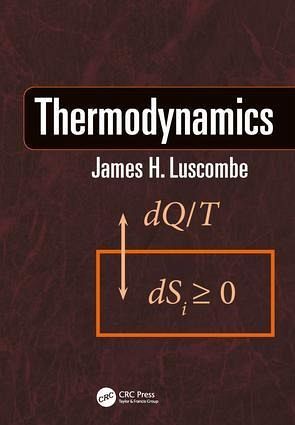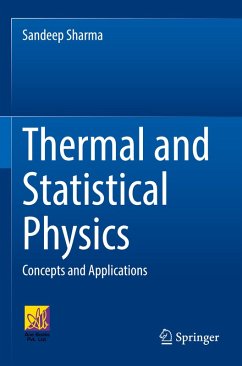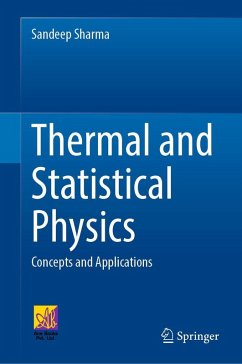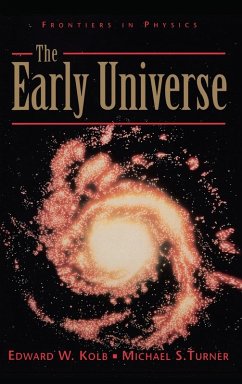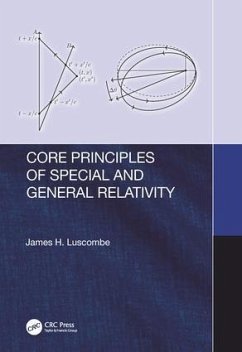James Luscombe
Gebundenes Buch
Thermodynamics
Versandkostenfrei!
Versandfertig in 1-2 Wochen
Weitere Ausgaben:

PAYBACK Punkte
55 °P sammeln!





This book provides an accessible yet thorough introduction to thermodynamics, suitable for advanced undergraduate and graduate students. Modern applications of thermodynamics are included throughout-something not offered to the same degree by existing texts in the field.
James H. Luscombe is Professor of Physics at the Naval Postgraduate School in Monterey, California. He received his PhD in Physics from the University of Chicago in 1983. After post-doctoral positions at the University of Toronto and Iowa State University, he joined the Research Laboratory of Texas Instruments, where he worked on the development of nanoelectronic devices, before joining the Naval Postgraduate School in 1994. He was Chair of the Department of Physics between 2003 and 2009. He teaches a wide variety of topics, including general relativity, statistical mechanics, mathematical methods, and quantum computation.
Produktdetails
- Verlag: CRC Press
- Seitenzahl: 242
- Erscheinungstermin: 12. März 2018
- Englisch
- Abmessung: 260mm x 183mm x 18mm
- Gewicht: 658g
- ISBN-13: 9781138542983
- ISBN-10: 1138542989
- Artikelnr.: 52009946
Herstellerkennzeichnung
Libri GmbH
Europaallee 1
36244 Bad Hersfeld
gpsr@libri.de
"Hoorah! Professor Luscombe has done a wonderful service to graduate students and younger physicists who find themselves clueless when they encounter a subtlety of thermodynamics because their undergraduate course in "Thermal Physics" raced through thermodynamics to get to statistical mechanics."
-Prof. Andrew Zangwill, Georgia Institue of Technology
"The subject of thermodynamics is a difficult topic to grasp even by those who use it frequently. This upper-level treatment, Thermodynamics, helps fill in the details that many introductory textbooks do not, and should not, provide. Oftentimes in this subject, as students especially, one is required to press the "I believe" button in order to
-Prof. Andrew Zangwill, Georgia Institue of Technology
"The subject of thermodynamics is a difficult topic to grasp even by those who use it frequently. This upper-level treatment, Thermodynamics, helps fill in the details that many introductory textbooks do not, and should not, provide. Oftentimes in this subject, as students especially, one is required to press the "I believe" button in order to
Mehr anzeigen
avoid a lengthy and scattered search required for piecing together the fundamental question in physics, "Why?", regarding the thermodynamic question at hand. This book, on the contrary, compiles many of those answers together in a step-by-step fashion and explains them in modern vernacular. While by no means is this a complete description of thermodynamics, nor does it claim to be, it provides a theoretical background and framework from which thermodynamics originates. For anyone looking to find a textbook that will fill in the gaps of prior teachings and provide the tools for understanding the fundamentals of thermodynamics, this textbook is a phenomenal resource to have available."
-Blake McCracken, Experimental Physicist
"Luscombe's Thermodynamics is an exciting addition to the field. The first thing you notice when opening the book is the engaging writing style. This is a textbook that does not read like a textbook. It makes you feel that the author is speaking with you directly, either one-to-one or in a small seminar. The structure of the book is sound. Its approach is to give equal weight and importance to thermodynamics and statistical mechanics, or put another way, to the macroscopic and microscopic. (As an example of Luscombe's engaging style, he refers to this as "the many and the few.") The overarching concept that ties the two together is entropy, and Luscombe makes understanding entropy his central theme. In the process the book covers all that I would find essential in either a thermodynamics or statistical mechanics book.
Although Luscombe's Thermodynamics is correctly described as "a science of matter that presupposes no knowledge of the constitution of matter," it is not for the faint-hearted. It is placed correctly as an advanced undergraduate or graduate-level textbook. For students in the former category, parts of it will be challenging. However, to his credit Luscombe has included a number of helpful "just in time" mathematical sections to ease the transition to upper-level math. One outstanding feature of Thermodynamics is that it includes additional topics in applied statistics and thermodynamics (in Section II). That is, these topics are not normally covered in a standard textbook in either field (statistical mechanics or thermodynamics), except perhaps in a brief or cursory way. In this section Luscombe has chosen some important topics of current interest, including superconductivity and superfluidity, non-equilibrium thermodynamics, and information theory. It may be asking a bit much to cover all these in a one-semester course, but an instructor can surely pick and choose some topics that are most interesting to students.
This is an outstanding book-well-structured and thorough in its analysis, yet a pleasure to read."
-Andrew Rex, Professor of Physics, University of Puget Sound
"A refreshing explanation of thermodynamics with many modern developments."
-Harvey Gould, Research Professor of Physics, Clark University
"The author presents a book gathering the bases of thermodynamics and applications to some physical situations. The book is divided in two main sections and fifteen chapters. It is completed with a reasonable list of references...Each chapter of the book ends with a summary of the main notions which are presented and of the results which are obtained. Each chapter is illustrated with many figures which help the reader to understand the notions which are presented. The book gathers the basic notions of thermodynamics with applications to interesting applications."
- Alain Brillard, Riedisheim, in Zentralblatt MATH 1400
-Blake McCracken, Experimental Physicist
"Luscombe's Thermodynamics is an exciting addition to the field. The first thing you notice when opening the book is the engaging writing style. This is a textbook that does not read like a textbook. It makes you feel that the author is speaking with you directly, either one-to-one or in a small seminar. The structure of the book is sound. Its approach is to give equal weight and importance to thermodynamics and statistical mechanics, or put another way, to the macroscopic and microscopic. (As an example of Luscombe's engaging style, he refers to this as "the many and the few.") The overarching concept that ties the two together is entropy, and Luscombe makes understanding entropy his central theme. In the process the book covers all that I would find essential in either a thermodynamics or statistical mechanics book.
Although Luscombe's Thermodynamics is correctly described as "a science of matter that presupposes no knowledge of the constitution of matter," it is not for the faint-hearted. It is placed correctly as an advanced undergraduate or graduate-level textbook. For students in the former category, parts of it will be challenging. However, to his credit Luscombe has included a number of helpful "just in time" mathematical sections to ease the transition to upper-level math. One outstanding feature of Thermodynamics is that it includes additional topics in applied statistics and thermodynamics (in Section II). That is, these topics are not normally covered in a standard textbook in either field (statistical mechanics or thermodynamics), except perhaps in a brief or cursory way. In this section Luscombe has chosen some important topics of current interest, including superconductivity and superfluidity, non-equilibrium thermodynamics, and information theory. It may be asking a bit much to cover all these in a one-semester course, but an instructor can surely pick and choose some topics that are most interesting to students.
This is an outstanding book-well-structured and thorough in its analysis, yet a pleasure to read."
-Andrew Rex, Professor of Physics, University of Puget Sound
"A refreshing explanation of thermodynamics with many modern developments."
-Harvey Gould, Research Professor of Physics, Clark University
"The author presents a book gathering the bases of thermodynamics and applications to some physical situations. The book is divided in two main sections and fifteen chapters. It is completed with a reasonable list of references...Each chapter of the book ends with a summary of the main notions which are presented and of the results which are obtained. Each chapter is illustrated with many figures which help the reader to understand the notions which are presented. The book gathers the basic notions of thermodynamics with applications to interesting applications."
- Alain Brillard, Riedisheim, in Zentralblatt MATH 1400
Schließen
Für dieses Produkt wurde noch keine Bewertung abgegeben. Wir würden uns sehr freuen, wenn du die erste Bewertung schreibst!
Eine Bewertung schreiben
Eine Bewertung schreiben
Andere Kunden interessierten sich für




